Table of Contents
- Introduction
- Editor’s Choice
- History of Rum
- Rum Market Overview
- Revenue Per Capita
- Global Rum Consumption Statistics
- Price of Rum
- Leading Rum Brands Worldwide – Based On Sales Volume Statistics
- Top Nations Exporting Rum and Tafia Statistics
- Top Nations Importing Rum and Tafia Statistics
- Nutritional Constituents in Rum Statistics
- Consumer Preferences for Rum Statistics
- Regulations for Rum Statistics
- Recent Developments
- Conclusion
- FAQs
Introduction
Rum Statistics: Rum, a distilled alcoholic drink or beverage derived from sugarcane by-products, holds a storied history dating back to the 17th century Caribbean.
Its production process involves fermentation of sugarcane by-products, distillation, aging in wooden barrels, and blending to achieve desired flavor profiles.
Varieties include light rum, known for its mild taste, and gold rum, with richer flavors. Dark rum has deep complexities; spiced rum is infused with aromatic spices, and over-proof rum boasts a higher alcohol content.
Used in cocktails, cooking, and sipping neat, rum’s versatility and diverse flavors ensure its enduring popularity worldwide, especially as demand for premium and craft rums grows.
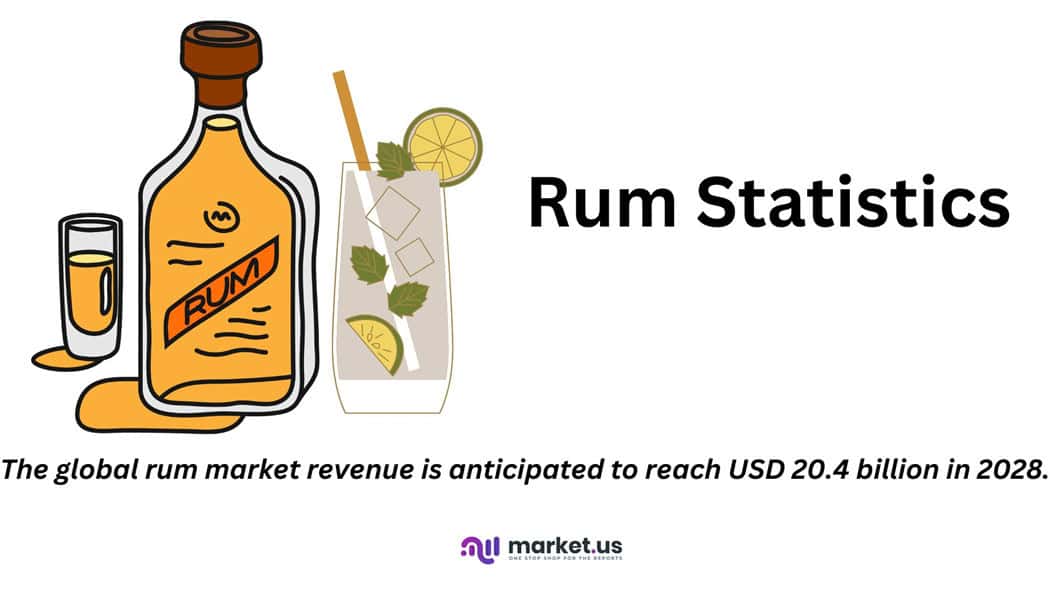
Editor’s Choice
- The global rum market revenue is anticipated to reach USD 20.4 billion in 2028.
- The forecast for 2025 and beyond indicates a steady state. Offline sales are projected to hold 97.7% of the market share and online sales are expected to remain at 2.6% through 2027.
- The global rum market is characterized by a diverse range of companies, with private labels leading the market at 9%.
- The United States leads with a substantial market revenue of USD 1,549 million.
- The global rum consumption statistics for out-of-home settings are projected to reach 111.4 million liters in 2028.
- In 2022, the leading rum brands worldwide, based on sales volume, demonstrated significant market presence. Tanduay led the market with an impressive sales volume of 27.5 million 9-liter cases.
- In 2022, Italy led the global rum export market with a total export value of USD 226 million, accounting for 11.20% of the market.
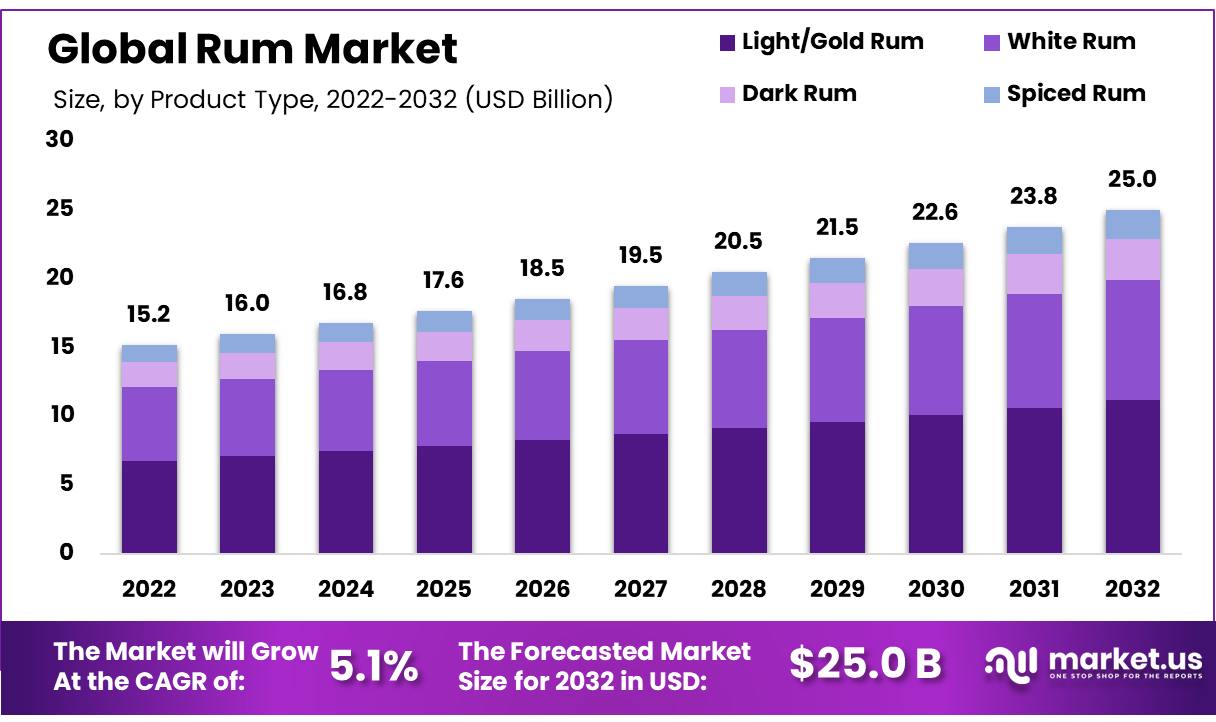
History of Rum
- The history of rum is a fascinating journey that dates back to the early 17th century, primarily originating in the Caribbean. The production of rum began on sugar plantations in the West Indies, where molasses, a by-product of sugar production, was distilled into this iconic spirit.
- By the mid-1600s, rum had become popular among sailors and pirates. Who relied on it for sustenance and morale during long voyages.
- The British Navy even adopted rum as part of their sailors’ rations, a tradition that lasted until 1970.
- Rum also played a significant role in the American colonies, particularly in New England. Where it was distilled locally and became central to the economy. It was a key component of the Triangular Trade, linking the colonies with the Caribbean and Africa.
- The American Revolution further cemented rum’s place in history. It became a symbol of resistance against British taxation, leading to events like the Boston Tea Party.
- The Prohibition era in the United States (1920-1933) marked another pivotal chapter for rum. Despite the ban on alcohol, rum remained popular in underground bars and speakeasies. Contributing to the creation of classic cocktails such as the Daiquiri and Mojito.
- Today, rum continues to be a beloved spirit worldwide, celebrated for its rich history and cultural significance.
(Sources: The Crafty Cask, Rumeography, The Rum Company)
Rum Market Overview
Global Rum Market Size Statistics
- The global rum market has experienced fluctuations over the past several years.
- In 2018, the market revenue stood at USD 15.9 billion, slightly decreasing to USD 15.8 billion in 2019.
- A notable decline occurred in 2020, with revenue dropping to USD 13.8 billion. Likely influenced by the global economic impact of the COVID-19 pandemic.
- However, the market began to recover in 2021, with revenue increasing to USD 14.4 billion.
- This recovery continued in 2022, reaching USD 15.1 billion and further to USD 15.8 billion in 2023.
- The upward trend is projected to persist, with the market expected to achieve USD 17.0 billion in 2024, USD 17.8 billion in 2025, USD 18.7 billion in 2026, USD 19.6 billion in 2027, and USD 20.4 billion in 2028.
- This progression indicates a resilient and growing demand for rum in the global market.
(Source: Statista)
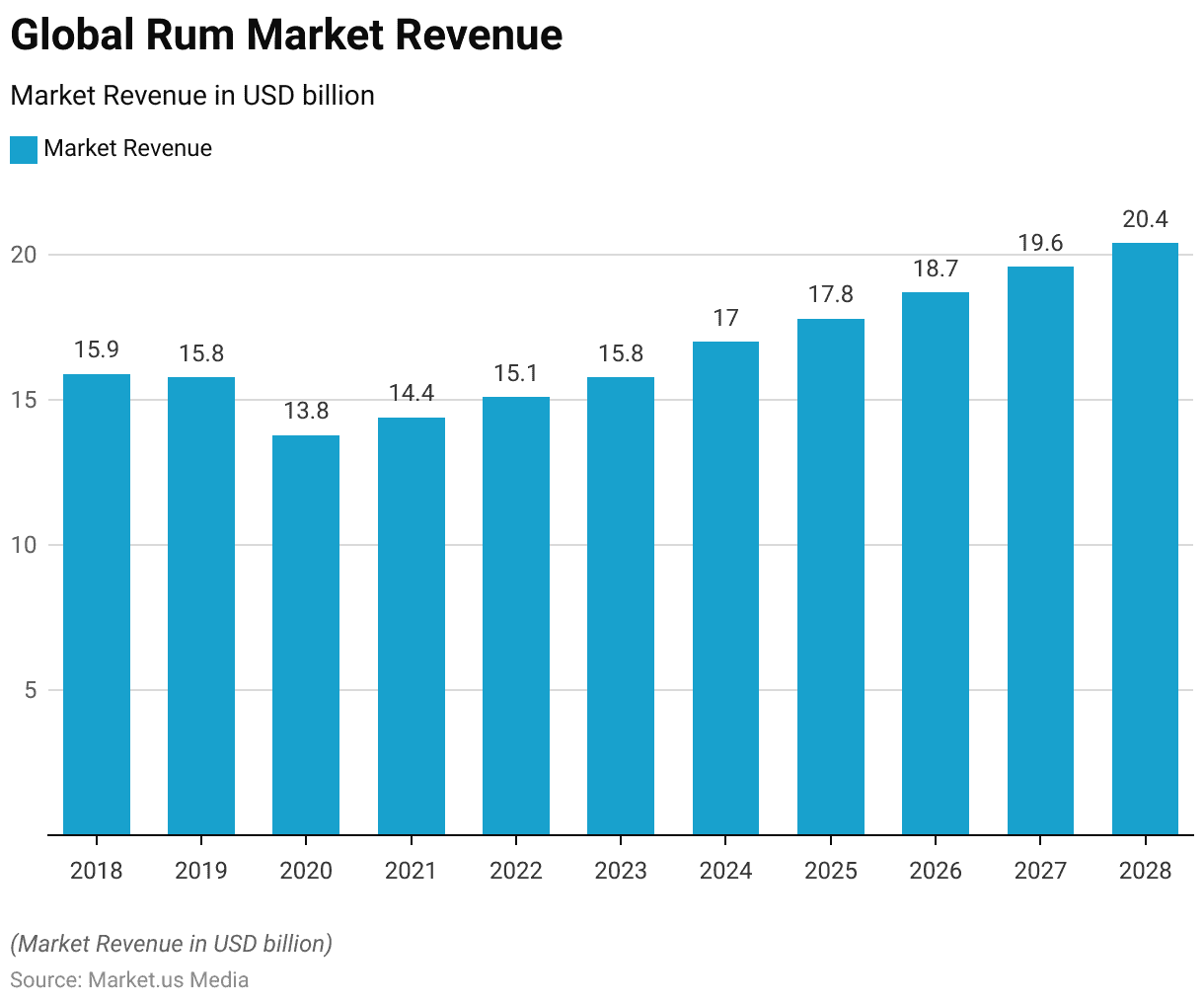
Global Rum Market Revenue Trends: At-Home vs. Out-of-Home Statistics
- The global rum market has demonstrated varied revenue trends in recent years, with distinct differences between at-home and out-of-home consumption.
- In 2018, the total market revenue was USD 15.9 billion, with USD 10.2 billion generated from at-home sales (e.g., supermarkets and convenience stores) and USD 5.8 billion from out-of-home sales (e.g., restaurants and bars).
- The following year, in 2019, the market saw a slight decline to USD 15.8 billion. With at-home revenue at USD 10.1 billion and out-of-home revenue at USD 5.7 billion.
- In 2020, the total market revenue dropped to USD 13.8 billion, attributed to the COVID-19 pandemic, With at-home revenue remaining steady at USD 10.1 billion while out-of-home revenue fell significantly to USD 3.7 billion.
- The market began recovering in 2021, with total revenue increasing to USD 14.4 billion. Driven by USD 10.6 billion in at-home sales and USD 3.8 billion in out-of-home sales.
- In 2022, the total revenue rose to USD 15.1 billion, with at-home revenue at USD 10.1 billion and out-of-home revenue improving to USD 4.4 billion.
- By 2023, the market further recovered to USD 15.8 billion. With at-home sales reaching USD 11.0 billion and out-of-home sales at USD 4.8 billion.
- Projections for 2024 suggest a total market revenue of USD 17.0 billion. With at-home and out-of-home revenues at USD 11.7 billion and USD 5.3 billion, respectively.
- The upward trend is expected to continue through 2025, with total revenue at USD 17.8 billion, followed by USD 18.7 billion in 2026, USD 19.6 billion in 2027, and USD 20.4 billion in 2028.
- By 2028, at-home revenue is anticipated to reach USD 13.3 billion, while out-of-home revenue is expected to grow to USD 7.1 billion. This data underscores the resilient and growing demand for rum, both for at-home and out-of-home consumption.
(Source: Statista)
Take advantage of our unbeatable offer - buy now!


Rum Market Revenue Change (At Home) Statistics
- The global rum market has experienced varying rates of revenue change in the at-home segment over the past several years.
- In 2019, the market saw a slight decline of 0.8%, followed by a smaller decrease of 0.4% in 2020.
- However, 2021 marked a significant recovery with a notable increase of 5.6%.
- This upward trend continued in 2022, albeit at a slower rate, with a growth of 1.1%.
- In 2023, the at-home market revenue grew by 2.7%.
- Projections for the upcoming years indicate a more robust growth trajectory, with an anticipated increase of 6.1% in 2024.
- The growth rates for 2025 and 2026 are expected to be 2.9% and 3.2%, respectively.
- The positive trend is projected to continue in 2027 with a 3.1% increase, culminating in a 4.0% growth in 2028.
- This data reflects a resilient and steadily growing demand for rum in the at-home consumption segment.
(Source: Statista)
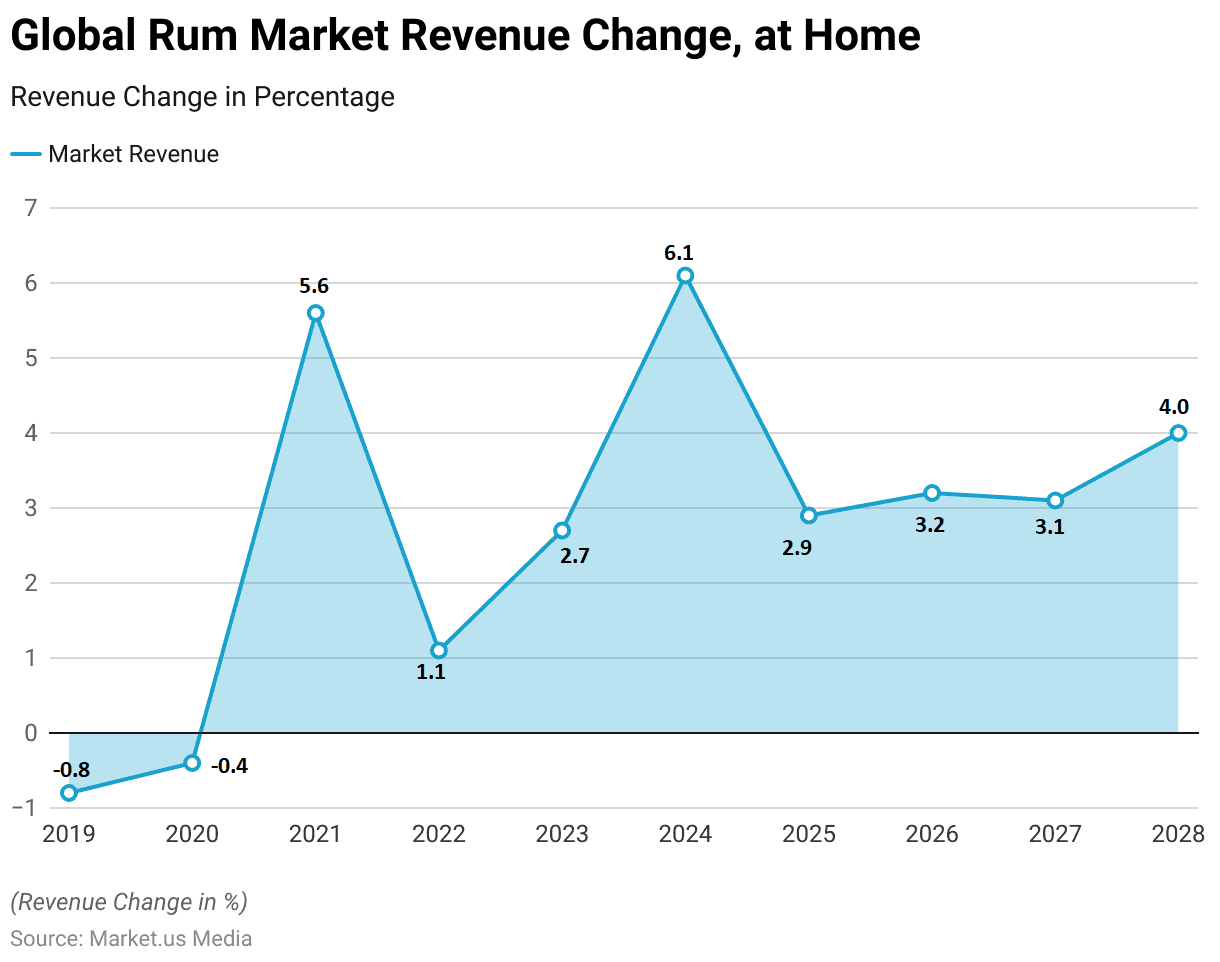
Rum Market Share – By Sales Channel Statistics
- Offline sales channels have predominantly driven the global rum market over the past several years.
- In 2017, offline sales accounted for 98.9% of the market share, while online sales contributed a mere 1.1%.
- This trend continued in 2018 and 2019, with offline sales holding 98.8% and 98.7% of the market share, respectively, and online sales gradually increasing to 1.2% and 1.3%.
- A significant shift occurred in 2020 when the COVID-19 pandemic accelerated the growth of online sales, leading to a decrease in offline sales to 97.9% and an increase in online sales to 2.1%. The trend persisted in 2021, with offline sales further declining to 97.4% and online sales rising to 2.6%.
- In 2022, the market saw a slight correction, with offline sales increasing to 97.5% and online sales decreasing to 2.5%. This minor fluctuation continued into 2023, where offline sales accounted for 97.6% and online sales for 2.4%.
- Projections for 2024 suggest a stabilization, with offline and online sales channels maintaining a market share of 97.5% and 2.5%, respectively.
- The forecast for 2025 and beyond indicates a steady state, with offline sales projected to hold 97.7% of the market share and online sales expected to remain at 2.6% through 2027.
- This data highlights the resilience of offline sales channels in the rum market while acknowledging the gradual but consistent growth of online sales channels.
(Source: Statista)
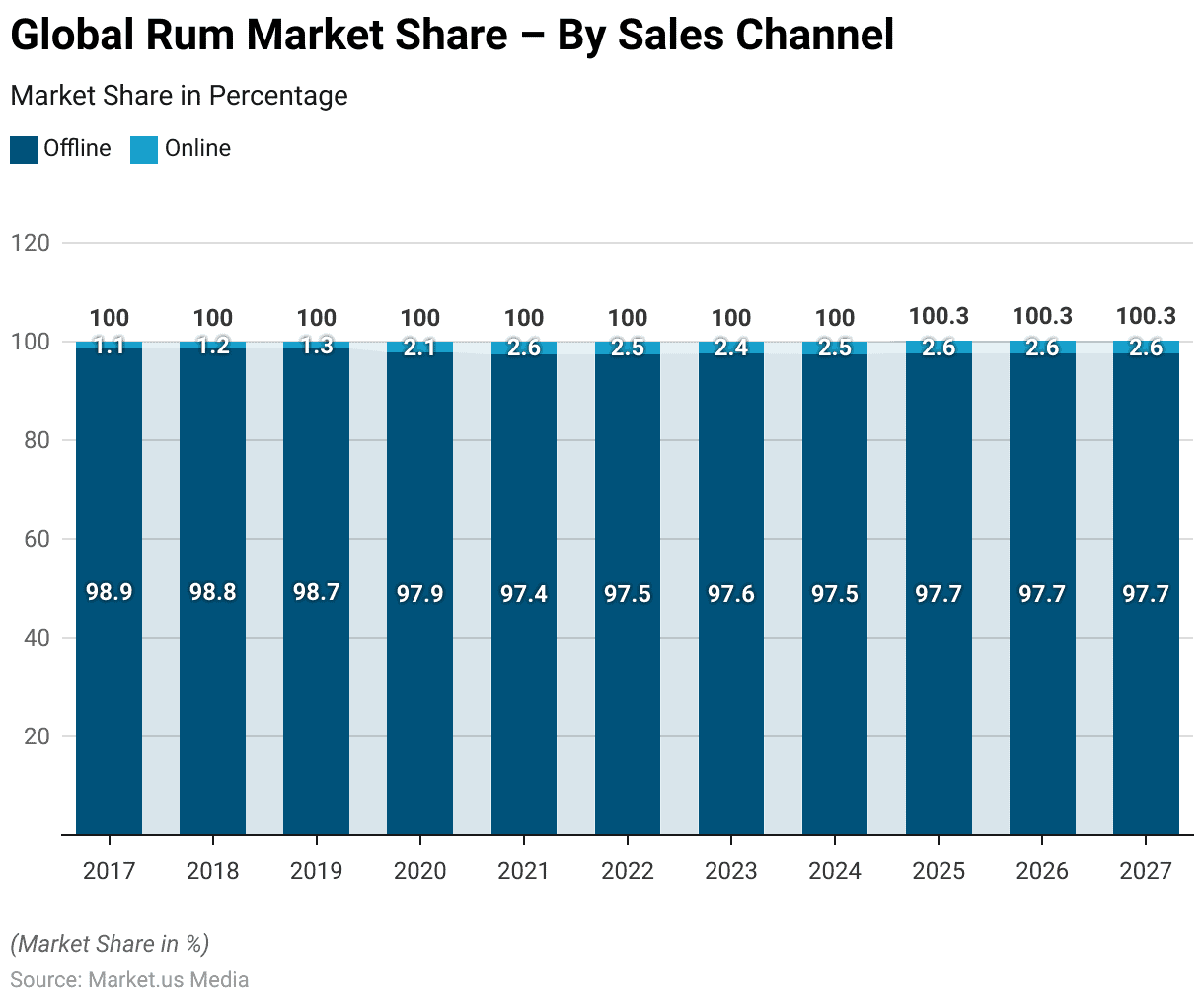
Competitive Landscape of the Global Rum Market Statistics
- The global rum market is characterized by a diverse range of companies, with a significant portion of the market share held by various brands and producers.
- Private Label leads the market with a 9% share, followed by Bacardi with 7% and Tanduay with 6%.
- Captain Morgan holds a 4% market share, while Appleton, Castillo, and Havana Club each command a 3% share.
- Barcelo and Santa Teresa each have a 2% market share, and Banks holds a 1% share.
- Notably, the remaining 60% of the market is occupied by other brands. Indicating a highly fragmented industry with numerous smaller players contributing to the overall market dynamics.
- This distribution underscores the competitive nature of the rum market, with no single brand dominating the landscape.
(Source: Statista)
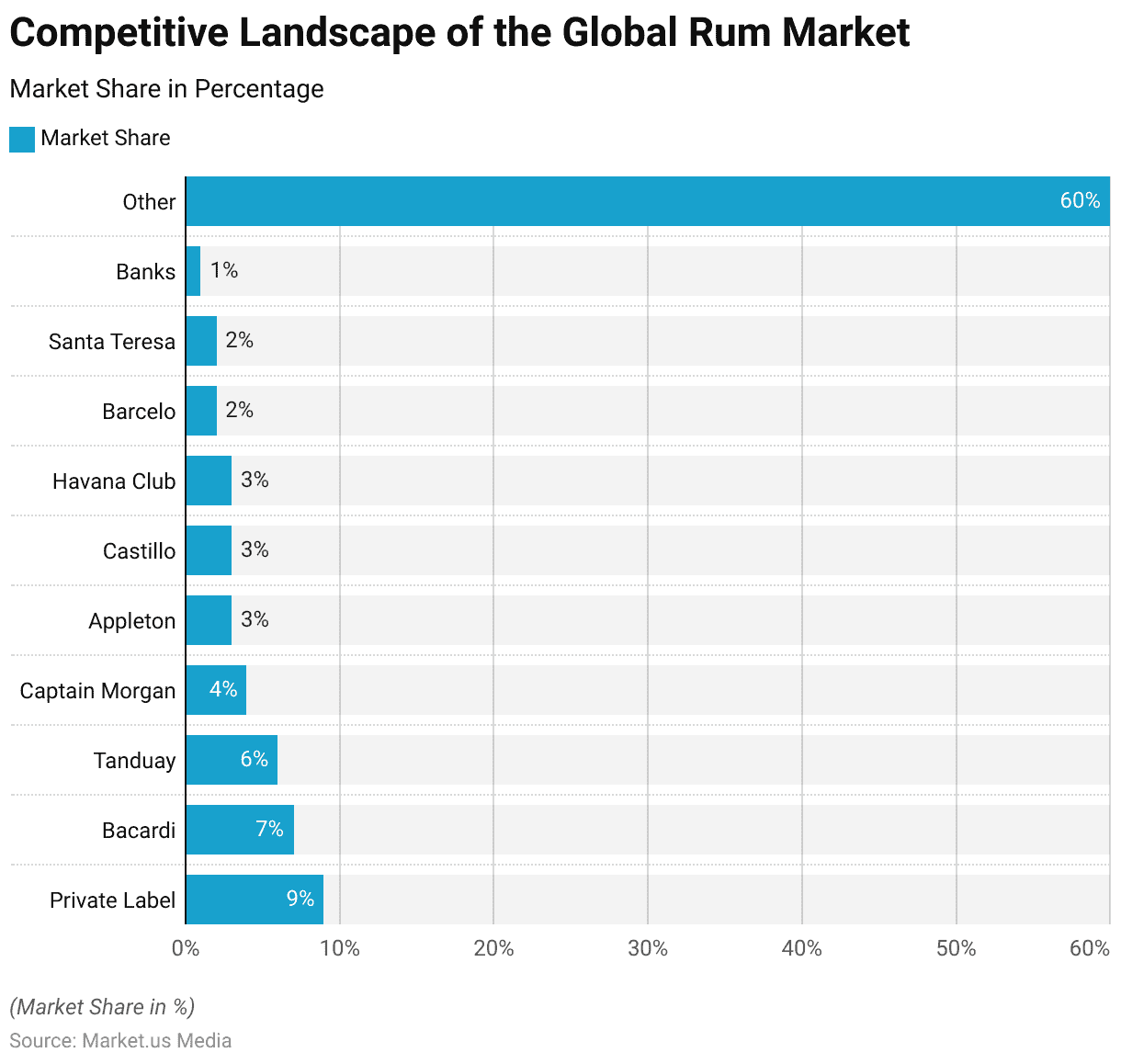
Regional Analysis of Rum Market Statistics
- The global rum market exhibits significant revenue contributions from various countries.
- The United States leads with a substantial market revenue of USD 1,549 million, followed by India, which generates USD 1,240 million.
- Germany also holds a notable position with a market revenue of USD 934 million.
- Spain and Canada contribute significantly to the market, with revenues of USD 779 million and USD 776 million, respectively.
- France follows closely with a revenue of USD 734 million.
- The United Kingdom and Brazil each have substantial market revenues. With the UK at USD 689 million and Brazil at USD 688 million.
- Additionally, Ukraine and the Philippines each contribute USD 268 million to the global rum market.
- This data highlights the diverse geographical distribution of rum market revenue, with prominent contributions from North America, Europe, and Asia.
(Source: Statista)
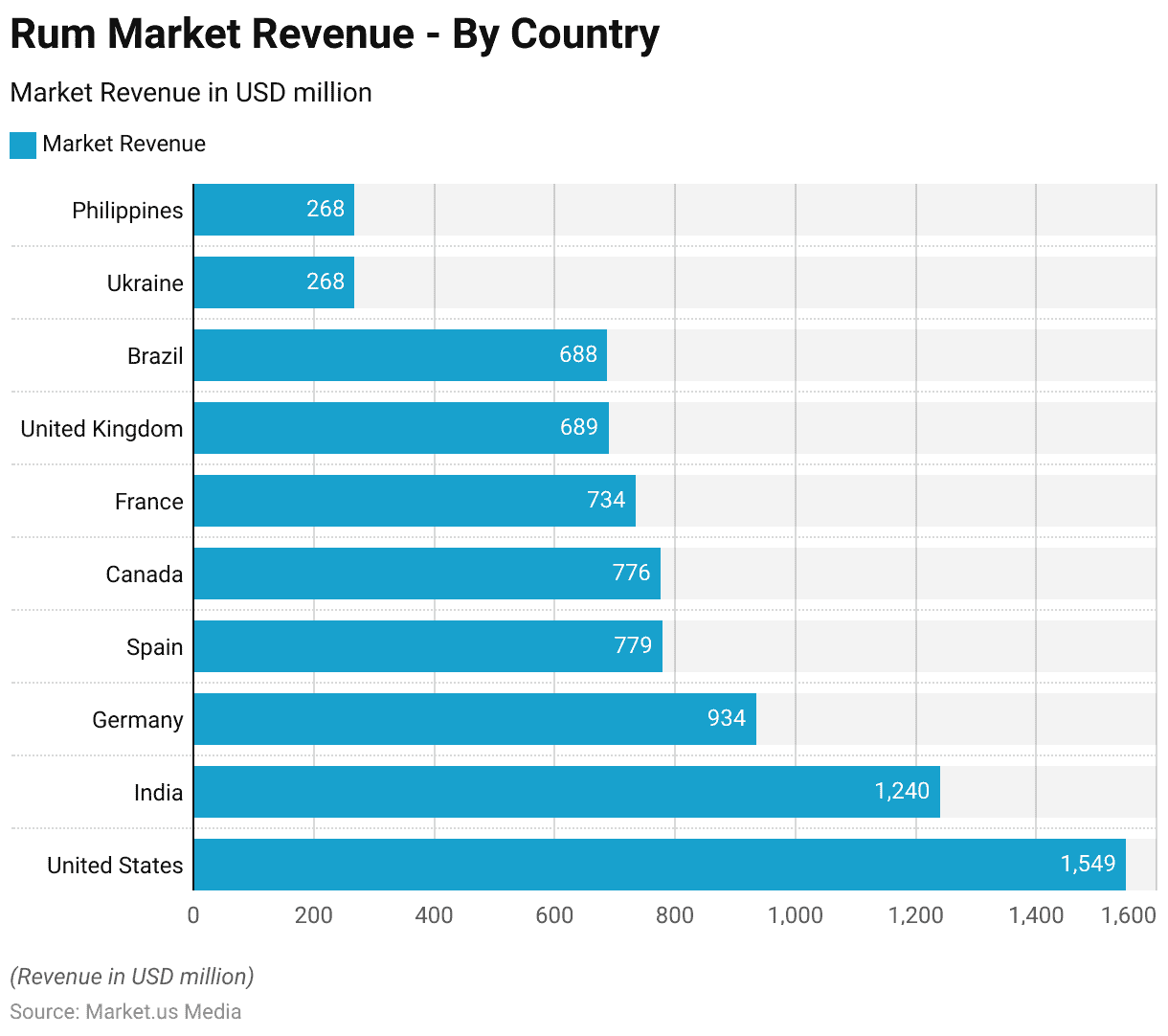
Revenue Per Capita
- The global rum market’s revenue per capita has demonstrated a fluctuating yet generally upward trend over the past several years.
- In 2018, the revenue per capita was USD 2.17, which slightly decreased to USD 2.13 in 2019.
- The year 2020 saw a more pronounced decline to USD 1.84, likely impacted by the global economic challenges of the COVID-19 pandemic.
- However, a recovery began in 2021, with revenue per capita rising to USD 1.91.
- This upward trajectory continued in 2022, reaching USD 1.99 and further to USD 2.05 in 2023.
- Projections indicate sustained growth in the coming years, with revenue per capita expected to increase to USD 2.2 in 2024, USD 2.28 in 2025, USD 2.38 in 2026, USD 2.47 in 2027, and USD 2.55 in 2028.
- This steady growth reflects a strengthening market and increasing consumer spending on rum.
(Source: Statista)

Revenue Per Capita Out of Home
- The revenue per capita out of home for the global rum market has experienced notable changes over the years.
- In 2018, the revenue per capita out of home was USD 0.78, slightly decreasing to USD 0.77 in 2019.
- The impact of the COVID-19 pandemic in 2020 led to a significant drop. Bringing the revenue down to USD 0.50, a figure that remained unchanged in 2021.
- A recovery began in 2022, with the revenue per capita increasing to USD 0.58.
- This upward trend continued in 2023, reaching USD 0.62.
- Projections indicate sustained growth, with the revenue per capita expected to rise to USD 0.69 in 2024, USD 0.74 in 2025, and USD 0.80 in 2026.
- Further increases are anticipated, with projections of USD 0.86 in 2027 and USD 0.88 in 2028.
- This data highlights the resilience and gradual recovery of the out-of-home segment of the rum market, reflecting increased social and recreational activities.
(Source: Statista)
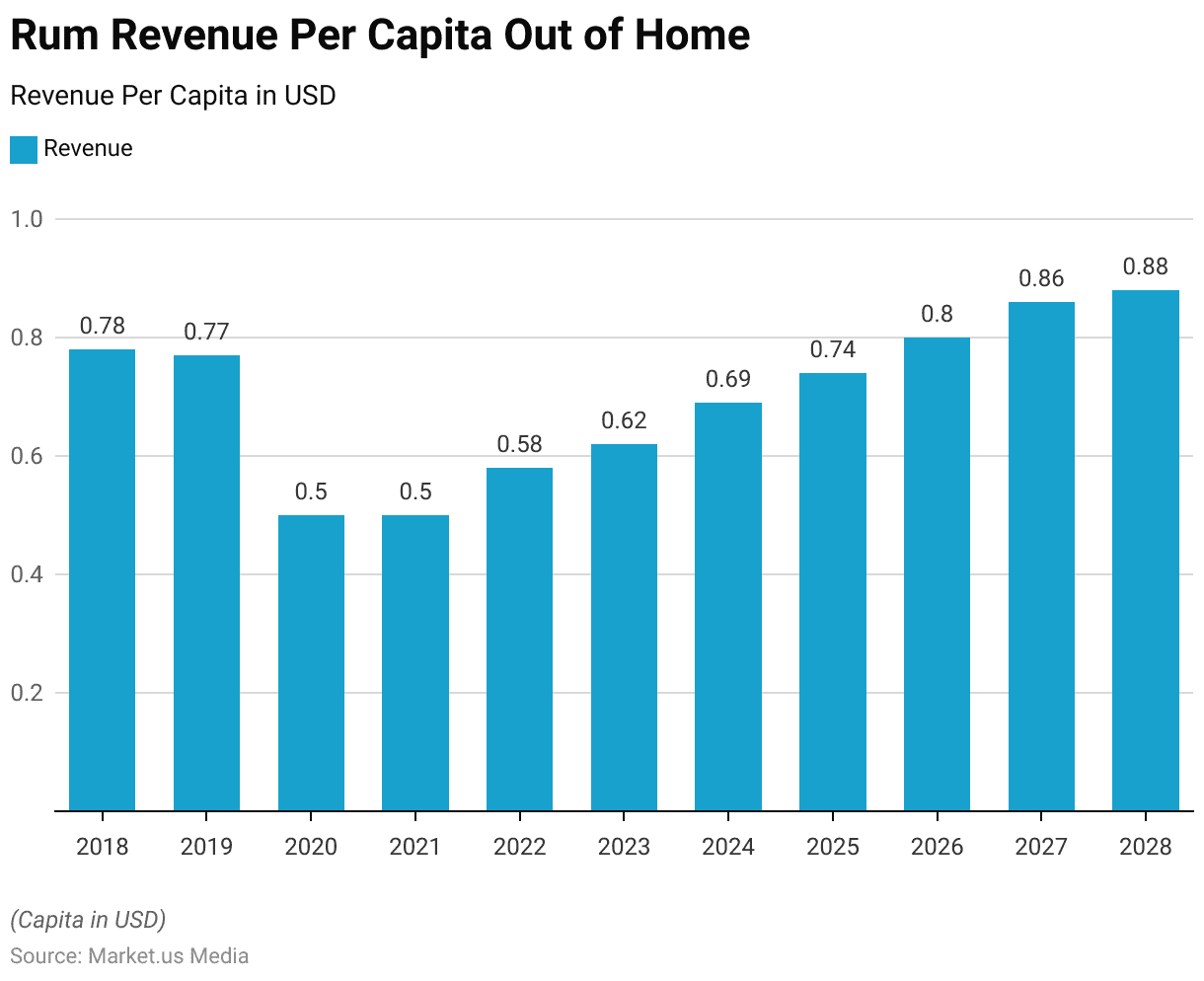
Average Revenue Per Capita at Home
- The average revenue per capita at home for the global rum market has shown a dynamic pattern over recent years.
- In 2018, the average revenue per capita stood at USD 1.38, which slightly decreased to USD 1.36 in 2019 and further to USD 1.34 in 2020.
- A recovery began in 2021, with the average revenue per capita increasing to USD 1.40.
- This upward trend continued in 2022 and 2023, with values rising to USD 1.41 and USD 1.43, respectively.
- Projections for the future indicate continued growth, with the average revenue per capita expected to reach USD 1.51 in 2024 and USD 1.54 in 2025.
- However, a notable drop to USD 1.28 is anticipated in 2026, followed by a rebound to USD 1.61 in 2027 and USD 1.66 in 2028.
- This data reflects a period of initial decline, followed by a strong recovery and projected growth in the at-home segment of the rum market.
(Source: Statista)
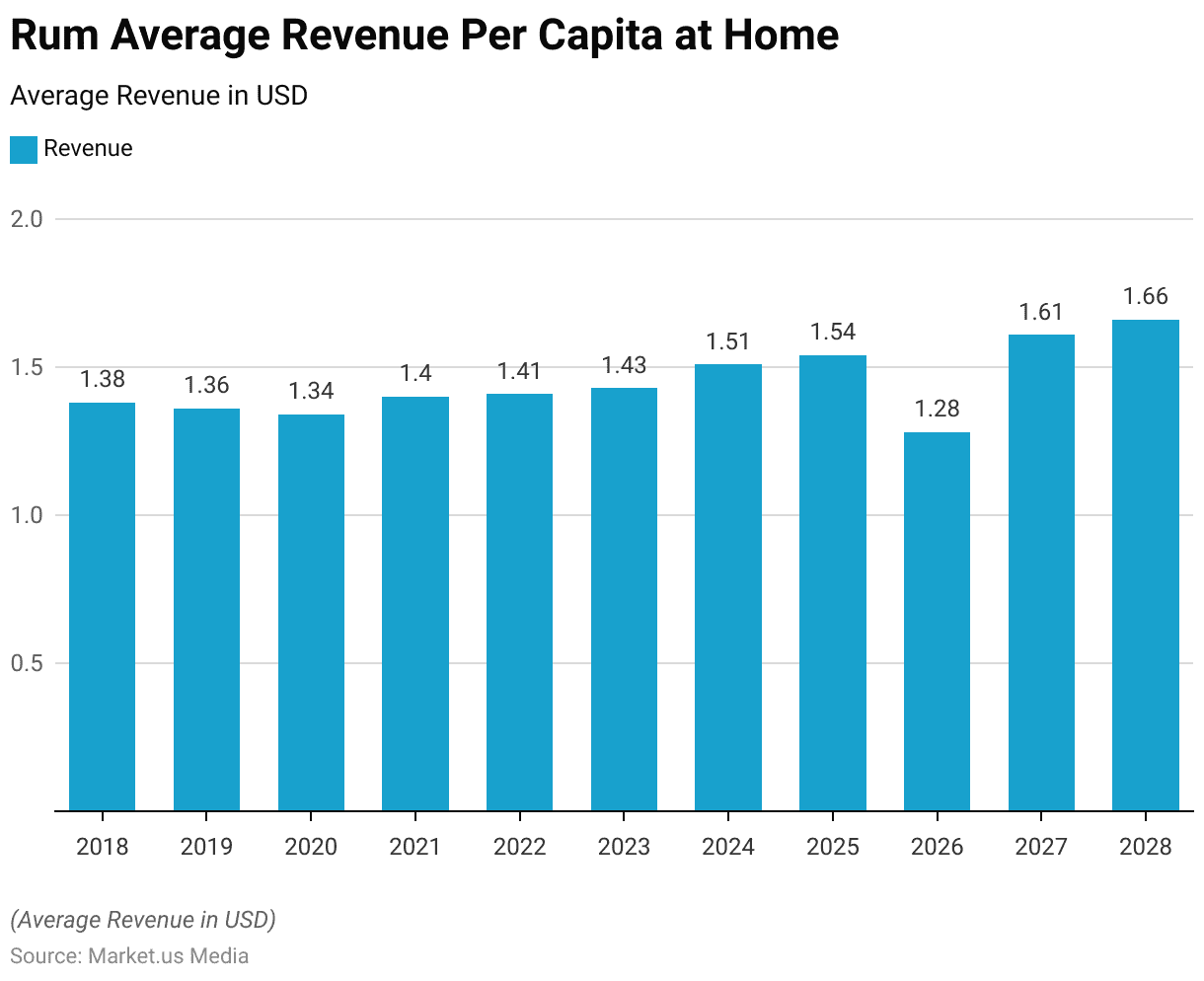
Global Rum Consumption Statistics
Rum Consumption Volume, Out-of-home
- The global rum consumption statistics for out-of-home settings have shown significant fluctuations over the past decade.
- In 2018, the volume consumed by homes was 119.7 million liters, slightly increasing to 120.3 million liters in 2019.
- The year 2020 marked a dramatic decline to 77.4 million liters. Largely due to the widespread impact of the COVID-19 pandemic on social and recreational activities.
- This downward trend continued into 2021, with consumption further decreasing to 74.4 million liters.
- However, recovery began in 2022, with out-of-home consumption rising to 80.7 million liters and further to 83.0 million liters in 2023.
- Projections for the coming years indicate a robust rebound. With expected consumption reaching 91.0 million liters in 2024, 97.2 million liters in 2025, and 103.7 million liters in 2026.
- The growth is anticipated to continue, with volumes reaching 110.1 million liters in 2027 and 111.4 million liters in 2028.
- This data underscores the recovery and growth in the out-of-home rum consumption market, reflecting increased social activities and consumer engagement.
(Source: Statista)
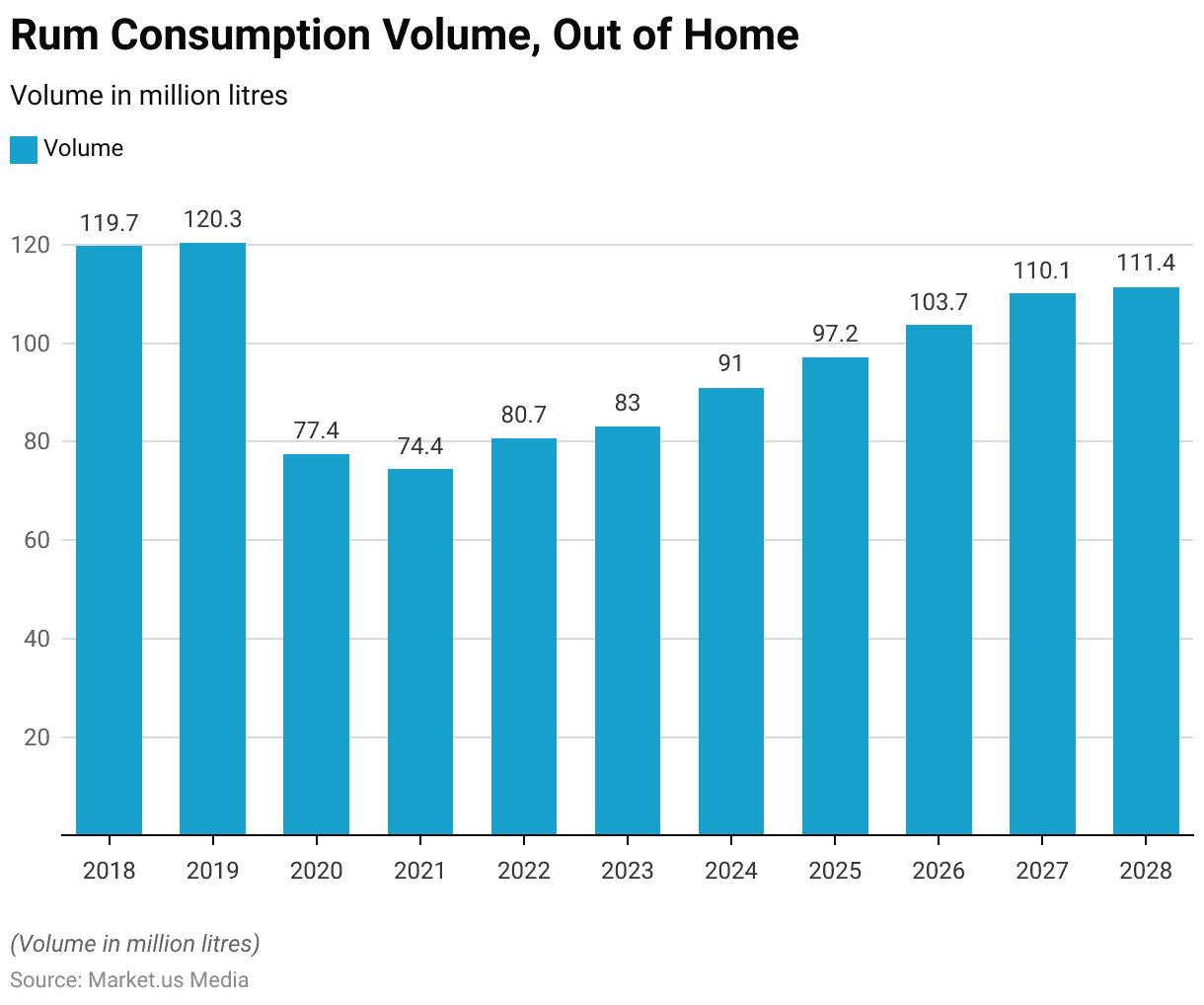
Change in Rum Consumption Value at Home
- The change in rum consumption value at home has experienced various shifts over recent years.
- In 2019, there was a slight decline of 0.3%.
- This downward trend continued into 2020 and 2021, with decreases of 1.1% and 1.2%, respectively.
- The most significant drop occurred in 2022, with a reduction of 3.6%.
- However, the market stabilized in 2023, showing no change in consumption value.
- Projections for 2024 indicate a positive turnaround with an expected increase of 1.8%.
- This upward trend is anticipated to persist, albeit at a slower pace. With projected increases of 0.4% in 2025, 0.8% in 2026, 0.7% in 2027, and 1.1% in 2028.
- This data highlights a period of decline followed by a gradual recovery in the value of rum consumption at home.
(Source: Statista)
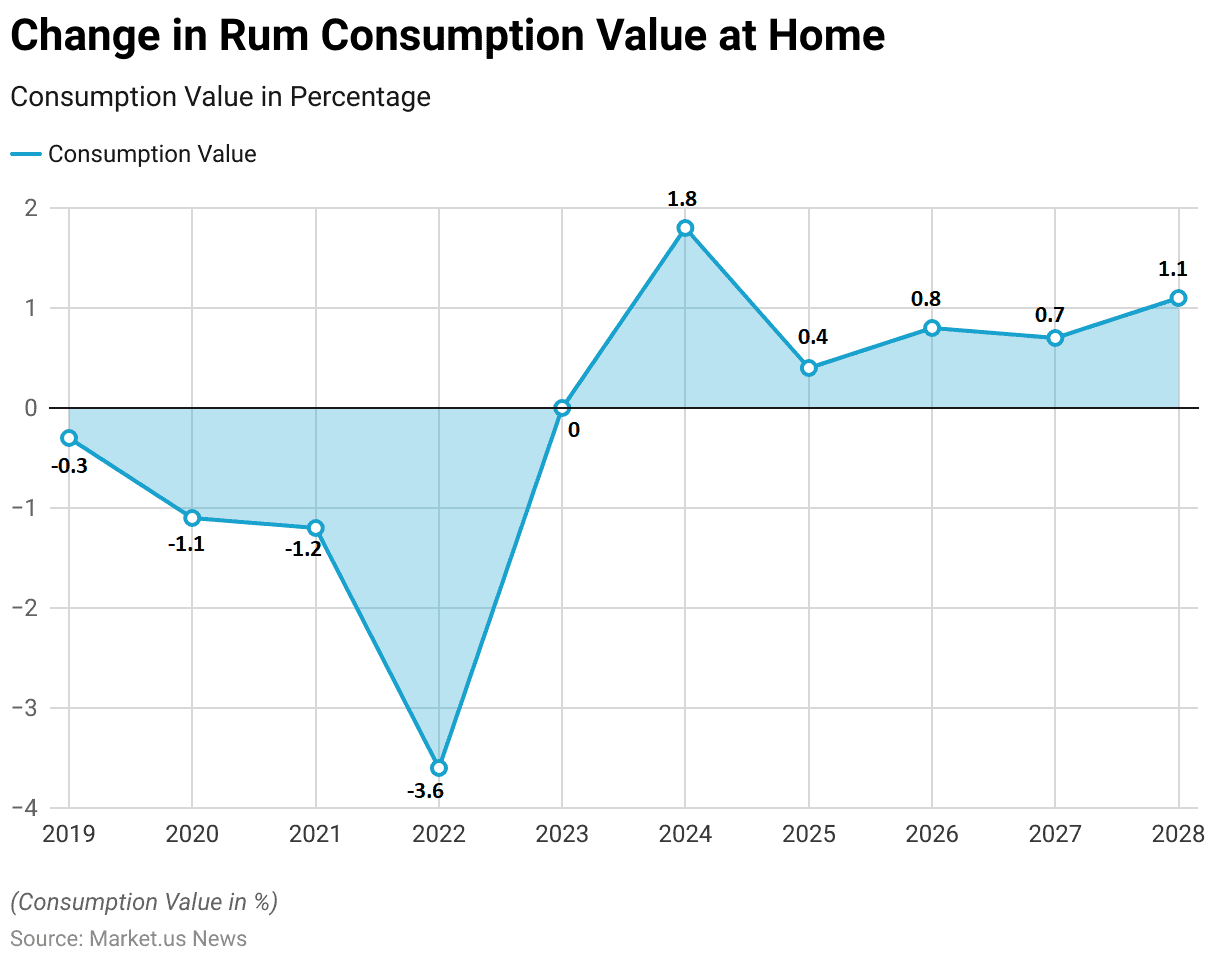
Price of Rum
Overall Price
- The overall price of rum has exhibited significant fluctuations and a general upward trend over the past decade.
- In 2018, the price of rum was USD 15.84, slightly decreasing to USD 15.73 in 2019.
- The year 2020 saw a notable decline to USD 14.47, likely influenced by market disruptions during the COVID-19 pandemic.
- However, a recovery was evident in 2021, with prices rising to USD 15.35.
- This upward momentum continued into 2022, with the price increasing to USD 16.56 and further to USD 17.21 in 2023.
- Projections indicate that this trend will persist, with the price expected to reach USD 18.12 in 2024, USD 18.79 in 2025, and USD 19.47 in 2026.
- Further increases are anticipated, with the price projected to be USD 20.14 in 2027 and USD 20.38 in 2028.
- This data reflects the resilience and growing value of the rum market. Highlighting a steady increase in prices over the years.
(Source: Statista)

Price Per Unit – At Home
- The price per unit of rum for at-home consumption has shown a consistent upward trend over the past several years.
- In 2018, the price per unit was USD 11.47, slightly decreasing to USD 11.41 in 2019.
- The price remained relatively stable in 2020 at USD 11.48.
- However, 2021 marked the beginning of a significant increase, with the price rising to USD 12.28.
- This upward trend continued, reaching USD 12.87 in 2022 and USD 13.22 in 2023.
- Projections for the future indicate further increases, with the price expected to be USD 13.77 in 2024, USD 14.11 in 2025, and USD 14.46 in 2026.
- The growth is anticipated to continue, with prices projected to reach USD 14.80 in 2027 and USD 15.22 in 2028.
- This data highlights a steady rise in the cost of rum for at-home consumption, reflecting increasing demand and market value.
(Source: Statista)
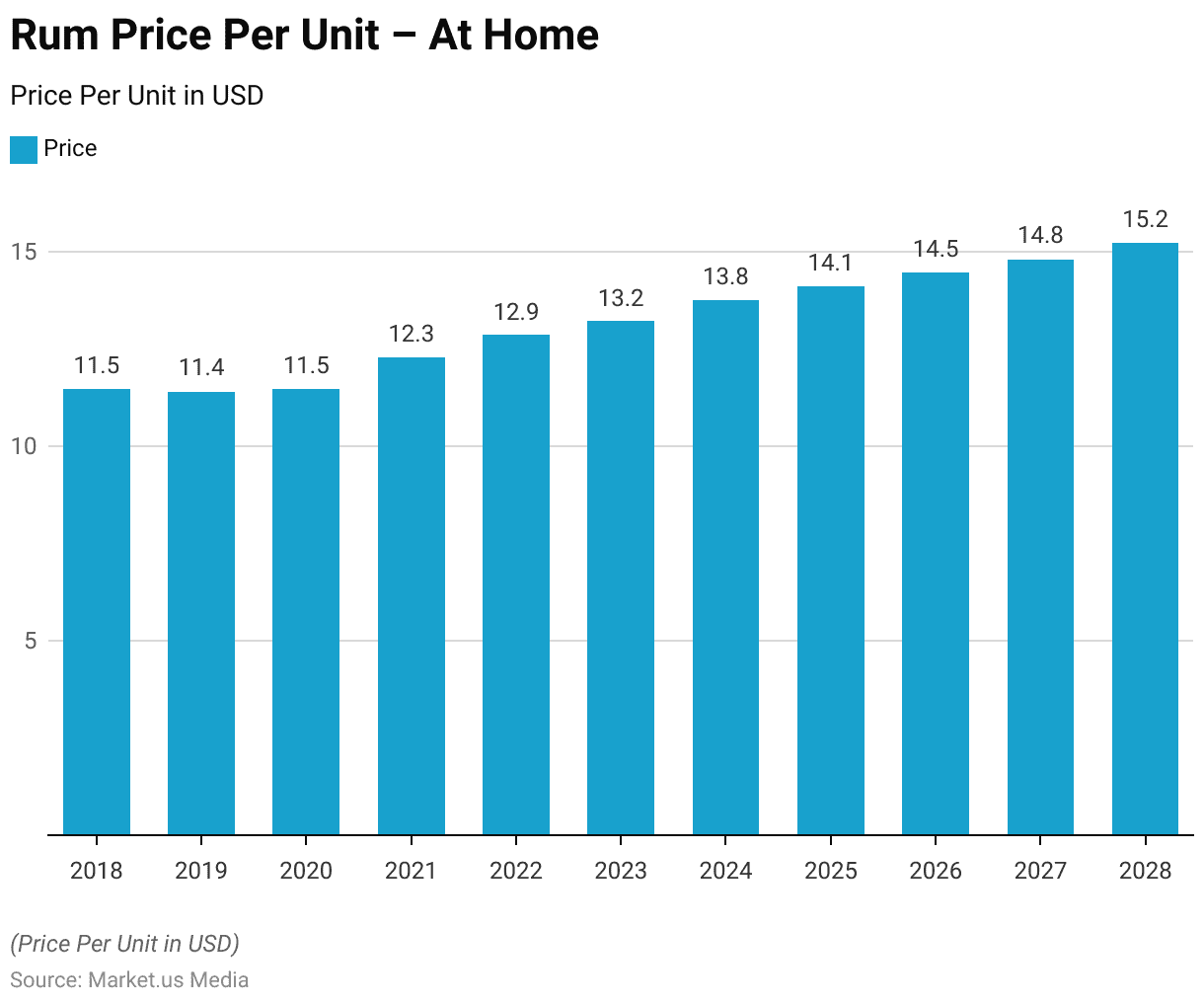
Price Out of Home
- The price of rum for out-of-home consumption has exhibited a general upward trend over recent years.
- In 2018, the price was USD 48.21, which slightly decreased to USD 47.52 in 2019.
- The price remained steady in 2020 at USD 48.20.
- However, 2021 saw a significant increase to USD 51.00.
- This rising trend continued into 2022, with the price reaching USD 54.69 and further to USD 57.27 in 2023.
- Projections for the coming years indicate continued growth, with the price expected to be USD 58.69 in 2024, USD 59.80 in 2025, and USD 60.95 in 2026.
- The upward trajectory is anticipated to persist, with prices projected to reach USD 62.09 in 2027 and USD 63.52 in 2028.
- This data underscores the increasing cost of rum for out-of-home consumption, reflecting growing demand and higher market value.
(Source: Statista)
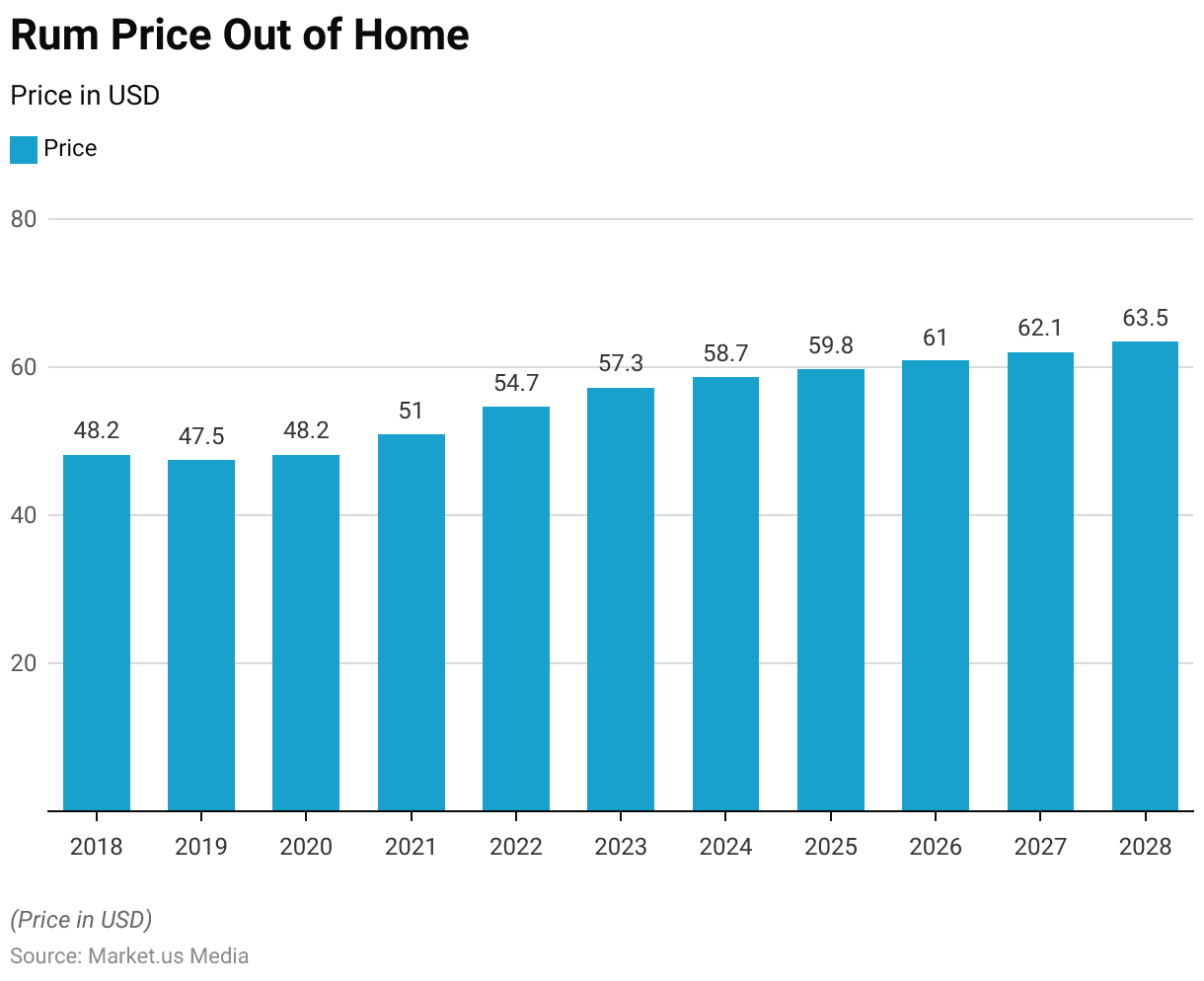
Leading Rum Brands Worldwide – Based On Sales Volume Statistics
- In 2022, the leading rum brands worldwide, based on sales volume, demonstrated significant market presence.
- Tanduay led the market with an impressive sales volume of 27.5 million 9-liter cases.
- Bacardi followed with 21.1 million 9-liter cases, and Captain Morgan secured the third position with 12.9 million 9-liter cases.
- McDowell’s No.1 Celebration also showed substantial sales, reaching 8.8 million 9-liter cases.
- Havana Club reported a sales volume of 4.6 million 9-liter cases, while Barcelo achieved 2.7 million 9-liter cases.
- Other notable brands included Contessa, with 1.3 million 9-liter cases, Appleton Jamaica, with 1.1 million 9-liter cases, and Montilla, with 1 million 9-liter cases.
- This data highlights the dominance of these brands in the global rum market, reflecting their strong consumer base and market penetration.
(Source: Statista)

Top Nations Exporting Rum and Tafia Statistics
- In 2022, Italy led the global rum export market with a total export value of USD 226 million, accounting for 11.20% of the market.
- The United States followed, exporting rum worth USD 199 million, representing 9.88% of the total exports.
- The Dominican Republic held a significant share, with exports valued at USD 162 million, or 8.05%.
- The Netherlands and France contributed USD 127 million (6.31%) and USD 124 million (6.15%) respectively.
- Spain’s rum exports amounted to USD 119 million, making up 5.19% of the market, while Venezuela exported USD 103 million worth of rum, representing 5.13%.
- Cuba and Guatemala also had notable export values, with USD 90.5 million (4.50%) and USD 89.1 million (4.43%) respectively.
- The United Kingdom rounded out the list with rum exports totaling USD 69.7 million, accounting for 3.46% of the global market.
- This data highlights the diverse geographical distribution of rum exports and the prominent role of these countries in the global rum trade.
(Source: OEC World)

Top Nations Importing Rum and Tafia Statistics
- In 2022, Germany was the leading importer of rum, with an import value of USD 177 million, accounting for 8.81% of the global market.
- The United States closely followed, importing rum worth USD 173 million, representing 8.62% of the market.
- Spain also had a significant share, with imports valued at USD 164 million, or 8.13%.
- The United Kingdom imported USD 144 million worth of rum, making up 7.14% of the total imports.
- The Netherlands and Italy contributed USD 127 million (6.13%) and USD 125 million (6.19%) respectively.
- Canada imported USD 110 million worth of rum, which constituted 5.49% of the market, while France’s imports were valued at USD 93.9 million (4.67%).
- Belgium and Czechia also had notable import values, with USD 76.2 million (3.79%) and USD 58.6 million (2.91%), respectively.
- This data highlights the key countries driving the global demand for rum imports in 2022.
(Source: OEC World)
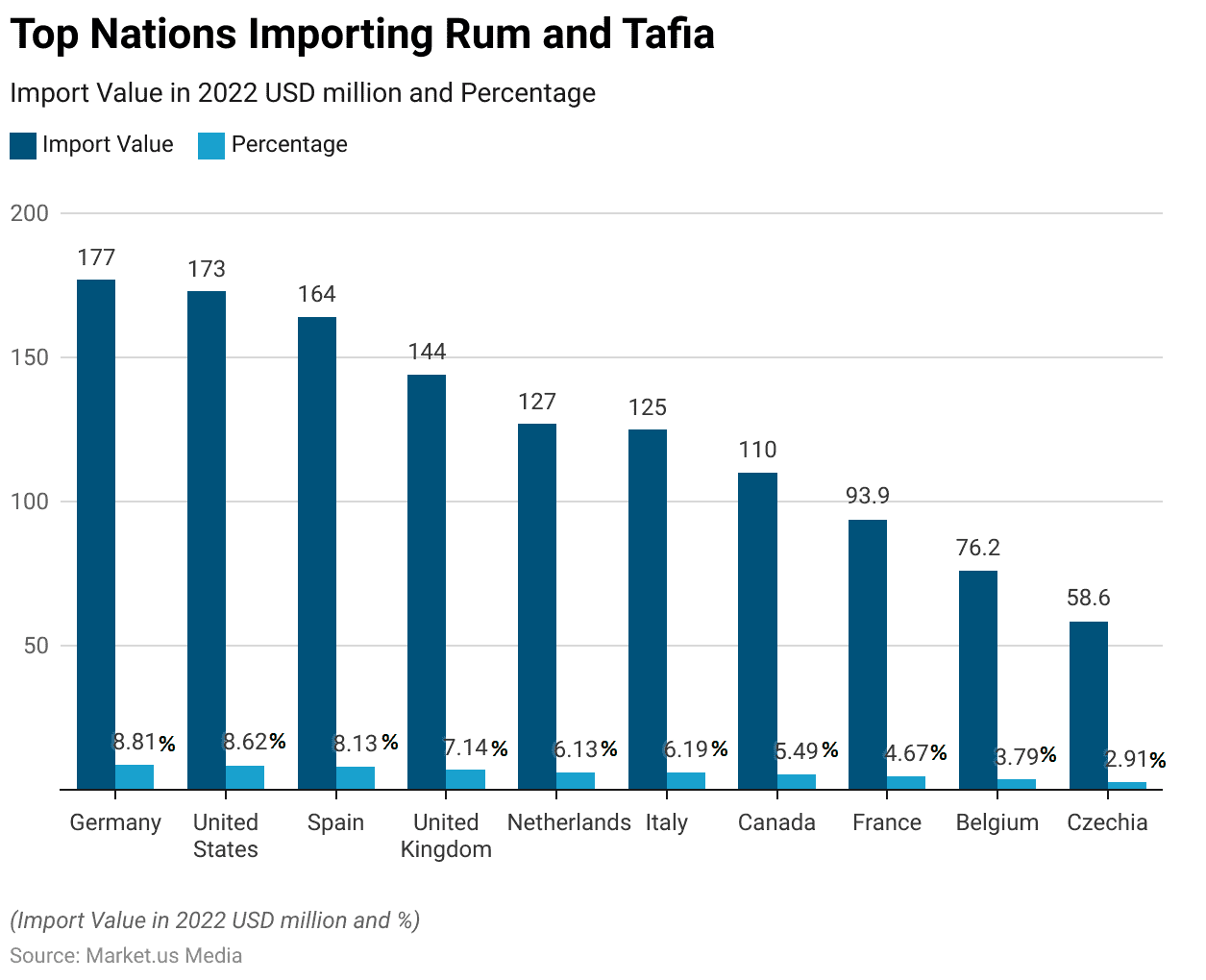
Nutritional Constituents in Rum Statistics
- Rum is an alcoholic beverage derived from sugarcane by-products, such as molasses or sugarcane juice, through a process of fermentation and distillation.
- From a nutritional standpoint, a standard serving of rum, which is typically 1.5 ounces, contains approximately 97 calories. Pure rum contains no fat, protein, carbohydrates, or sugars, making it a calorie-dense beverage purely from its alcohol content.
- The alcohol content in rum generally ranges around 40% by volume, though it can vary among different brands and types.
- Rum is also gluten-free and sodium-free, which can be beneficial for individuals with specific dietary restrictions. Despite being derived from sugarcane, the fermentation and distillation processes remove all sugars, resulting in zero carbohydrate content in pure rum.
- However, it is important to note that flavored or spiced rums may contain added sugars and other ingredients that can alter their nutritional profile. Additionally, rum does not provide significant vitamins or minerals.
- When consuming rum, it is crucial to do so in moderation due to the potential health risks associated with excessive alcohol consumption, such as increased risk for heart disease, liver damage, and other adverse health effects.
(Sources: very well fit, facts.net)
Consumer Preferences for Rum Statistics
- Consumer preferences for rum have shifted notably in recent years, with a growing interest in premium and craft varieties.
- In 2022, dark and golden rums dominated the market, accounting for 45.7% of the revenue due to their extended aging process and rich flavor profiles.
- Millennials and Gen Z consumers are particularly drawn to authentic and sustainably produced rums, valuing brands that demonstrate environmental and social responsibility.
- Flavored and spiced rums have also gained popularity, and they are projected to grow at a CAGR of 6.2% as consumers seek unique and enjoyable taste experiences.
(Source: Beverage Dynamics)
Regulations for Rum Statistics
- Regulations for rum vary significantly across different countries, reflecting the diverse legal and cultural attitudes towards this spirit.
- In the United States, rum regulations focus primarily on the base ingredients, with less stringent geographic protections compared to other spirits like cognac or bourbon. Puerto Rico, however, mandates that even white rum must be aged for at least one year and distilled at 189 proof.
- In the Caribbean, the West Indies Rum & Spirits Producers Association has established the Authentic Caribbean Rum (ACR) mark, which includes tiers based on base materials and age statements, to ensure quality and authenticity.
- In the European Union, regulations require clear labeling of alcohol content and prohibit misleading age statements, aiming to protect consumers and ensure transparency.
- Jamaica, a significant rum producer, has strict rules against adulteration and emphasizes maintaining its geographical indication (GI) status to preserve the authenticity and heritage of Jamaican rum. These varying regulations aim to balance the cultural significance and popularity of rum with public health and safety concerns, ensuring that consumers receive a quality and authentic product.
(Source: VinePair, Gov.UK, Jamaica Observer)
Recent Developments
Acquisitions:
- Brown‑Forman Corporation’s Acquisition of Diplomático Rum: In January 2023, Brown‑Forman Corporation completed the acquisition of the Diplomático Rum brand and related assets from Distillers United Group S.L.
- This acquisition marks Brown‑Forman’s entry into the growing super-premium rum category, expanding its portfolio and market presence.
New Product Launches:
- Bacardi’s Mango Chile Rum: In May 2023, Bacardi introduced Mango Chile, a new flavored rum that combines natural mango extracts with spicy chili and Bacardi white rum. This new variant, initially launched in Mexico, has been well-received in the U.S. market due to its unique and captivating flavor profile.
- Red Stripe’s Canned Rum Cocktails: In April 2023, Red Stripe expanded its product line by launching new canned rum cocktails in two flavors, Rum Punch and Rum Mojito. These cocktails have an alcohol by volume (ABV) of 5.9% and are made with real Caribbean rum, mango, lime juice, and natural flavors.
Funding:
- Expansion of Distilleries and Production Facilities: Various rum producers have been investing in expanding their distilleries and production capabilities to meet the growing demand for premium and craft rums.
- This includes investments in aging facilities and sustainable production practices to enhance the quality and authenticity of their products.
Market Growth:
- Global Rum Market Expansion: The growth is driven by increasing consumer interest in premium and craft rums, as well as the expanding cocktail culture.
- Asia-Pacific Dominance: The Asia-Pacific region accounted for the largest revenue share in the rum market in 2022 and is expected to continue its growth due to a large population, rising disposable incomes, and increasing popularity of rum among younger consumers. Countries like India and the Philippines are significant contributors to this growth.
Innovation in Rum Varieties:
- Introduction of New Flavored and Spiced Rums: Flavored and spiced rums are expected to grow at a CAGR of 6.2% over the forecast period.
- The continuous introduction of innovative products in these categories caters to the growing customer demand for unique and enjoyable taste profiles in cocktails.
Strategic Partnerships:
- Collaborations for Sustainable Practices: Many rum brands are focusing on sustainability and transparency in their production processes.
- Brands like Copalli Spirits emphasize eco-friendly practices and transparency about their carbon footprint to attract environmentally conscious consumers.
Conclusion
Rum Statistics – In summary, the rum market shows promising growth fueled by evolving consumer tastes and a surge in premium and craft spirits.
This expansion transcends traditional Caribbean origins, with significant growth seen in North America, Europe, and Asia-Pacific.
Product innovation, including flavored and aged rums, coupled with a focus on authenticity and sustainability, resonates well with discerning consumers.
Premiumization remains a key trend, driving investment in quality and unique experiences. Despite challenges such as regulatory complexities and competition from other spirits, opportunities abound for brands to differentiate through innovation and sustainable practices.
Overall, the rum market presents a vibrant landscape ripe with opportunities for stakeholders who can adapt to changing consumer preferences and market dynamics effectively.
FAQs
Rum is made from sugarcane by-products, primarily molasses or sugarcane juice, which are fermented and distilled. The distillate is typically aged in oak barrels to develop its flavor.
Rum’s primary distinction lies in its raw materials and aging process. Unlike whiskey, which is made from grains, or brandy, which is made from grapes, rum is derived from sugarcane. Additionally, rum can be produced in a variety of styles, including light, dark, spiced, and flavored, giving it a wide range of flavor profiles.
Some of the most well-known rum brands include Bacardi, Captain Morgan, Havana Club, Mount Gay, and Ron Zacapa. These brands offer a range of styles and are recognized globally for their quality and distinct flavors.
Rum should be stored in a cool, dark place, away from direct sunlight. Once opened, it is best to keep the bottle tightly sealed to maintain its quality and prevent evaporation.
A standard 1.5-ounce serving of rum contains about 97 calories with no fat, protein, carbohydrates, or sugars. It is gluten-free and sodium-free but should be consumed in moderation due to its alcohol content.
Discuss your needs with our analyst
Please share your requirements with more details so our analyst can check if they can solve your problem(s)



